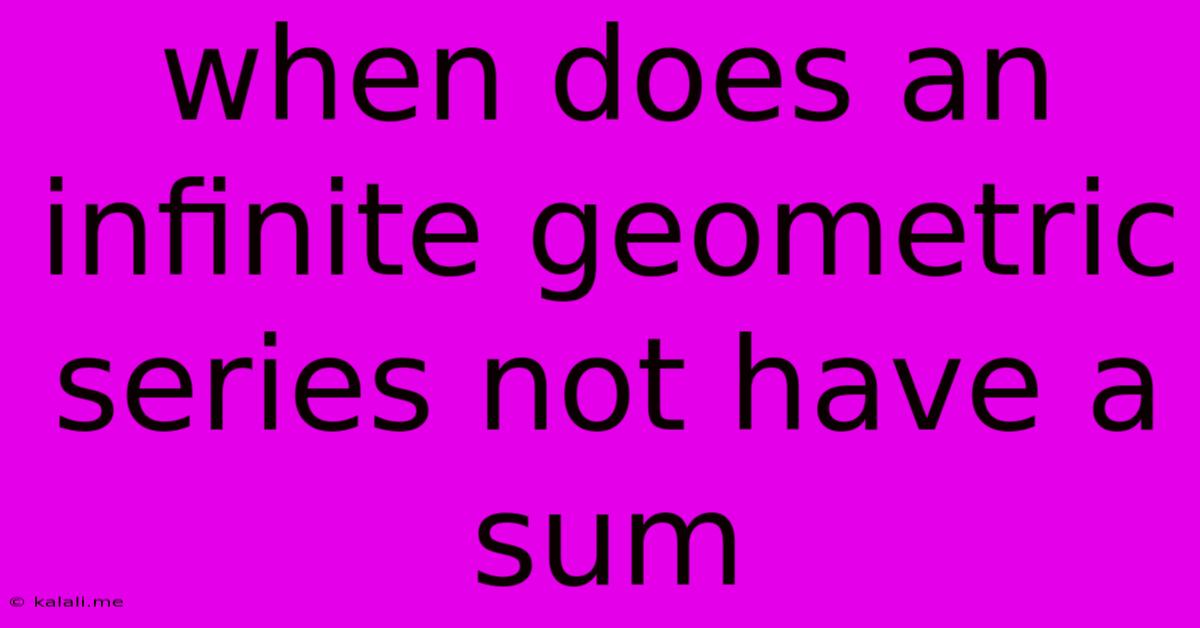When Does An Infinite Geometric Series Not Have A Sum
Kalali
Jun 06, 2025 · 3 min read

Table of Contents
When Does an Infinite Geometric Series Not Have a Sum?
Understanding infinite geometric series is crucial in various fields, from calculus to finance. While some infinite geometric series converge to a finite sum, others diverge, meaning their sum approaches infinity or doesn't exist. This article will explore the conditions under which an infinite geometric series fails to have a defined sum, explaining the underlying mathematical principles in a clear and concise way. We'll also look at examples to solidify your understanding.
An infinite geometric series is a series of numbers where each term is found by multiplying the previous term by a constant value, called the common ratio (often denoted as 'r'). The formula for the sum of an infinite geometric series is:
S = a / (1 - r)
where 'a' is the first term of the series and 'r' is the common ratio. This formula, however, only works under specific circumstances.
The Crucial Role of the Common Ratio (r)
The key to determining whether an infinite geometric series has a sum lies entirely in the value of its common ratio, 'r'. The series only converges to a finite sum if the absolute value of 'r' is less than 1: |r| < 1.
Let's break this down:
-
|r| < 1 (Convergent Series): When the absolute value of the common ratio is less than 1, each subsequent term in the series becomes smaller and smaller. The terms approach zero, and the series converges to a finite sum, as calculated by the formula above. This is because the decreasing terms contribute less and less to the overall sum, eventually becoming negligible. Examples include series with r = 1/2, r = -1/3, or r = 0.8.
-
|r| ≥ 1 (Divergent Series): If the absolute value of the common ratio is greater than or equal to 1, the terms in the series either stay the same size or get larger. The sum of the series increases without bound, approaching infinity (or negative infinity if 'r' is negative), meaning it diverges. There is no finite sum. Examples include series with r = 1, r = -1, r = 2, or r = -1.5.
Examples Illustrating Convergence and Divergence
Example 1: Convergent Series
Consider the series: 1 + 1/2 + 1/4 + 1/8 + ...
Here, a = 1 and r = 1/2. Since |r| = 1/2 < 1, this series converges. The sum is:
S = 1 / (1 - 1/2) = 2
Example 2: Divergent Series
Consider the series: 2 + 4 + 8 + 16 + ...
Here, a = 2 and r = 2. Since |r| = 2 ≥ 1, this series diverges. The sum approaches infinity.
Example 3: Another Divergent Series
Consider the series: 1 - 1 + 1 - 1 + ...
Here, a = 1 and r = -1. Since |r| = |-1| = 1 ≥ 1, this series also diverges. Although the terms oscillate between 1 and -1, they do not approach zero. Therefore, it does not converge to a specific sum.
Conclusion
In summary, an infinite geometric series only possesses a finite sum when the absolute value of its common ratio is less than 1 (|r| < 1). If the absolute value of the common ratio is greater than or equal to 1 (|r| ≥ 1), the series diverges, and no finite sum exists. Understanding this crucial distinction is fundamental to working with infinite geometric series in various mathematical and real-world applications.
Latest Posts
Latest Posts
-
Pizza With Broccoli In Inside Out Congratulations San Francisco
Jun 06, 2025
-
Length To Sister A Deck Joist For A Cantilevered Deck
Jun 06, 2025
-
How To Unclog My Bathtub Drain
Jun 06, 2025
-
Door Handle Only Works On One Side
Jun 06, 2025
-
How To Send A Text From A Different Number
Jun 06, 2025
Related Post
Thank you for visiting our website which covers about When Does An Infinite Geometric Series Not Have A Sum . We hope the information provided has been useful to you. Feel free to contact us if you have any questions or need further assistance. See you next time and don't miss to bookmark.